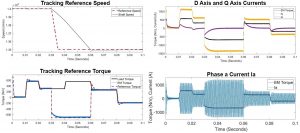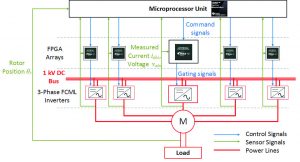Design of Modular and Robust Control Systems for High-Specific-Power Electric Machines
Xiaolong Zhang with adviser K. Haran
This work is motivated by recent trends to introduce electric machines and drives into the propulsion system of next-generation aircraft. A key machine design metric crucial to system optimization is specific power, or, power-to-mass ratio. High-speed, multiple-pole, slotless PM machine designs are capable of minimizing mass and maximizing specific power. However, this class of machines tends to have a very high electrical frequency (2,500 Hz) and low magnetizing inductance (0.06 per unit), which present a real challenge to its control system. A modular and robust control system has been designed, as shown in Figure 7. The system has one upper-level supervisory control center and five lower-level parallel modules. The control center collects real-time machine operating information and performs condition monitoring and rotor-speed

Figure 8: Speed and torque in electric machine control simulation & Current trajectories in electric machine control simulation
regulation functions. Each lower level module, composed of an array of FPGAs, receives command signals from the central microcontroller and controls a flying-capacitor, multilevel inverter. This modular structure makes the control very robust, such that any fault that occurs in one module can be contained in the local region and will not propagate into other modules.
We have explored four types of control algorithms to control currents fed into the machine windings. They include conventional proportional-integral (PI), feedforward decoupling PI, feedback decoupling PI and phase-shifted PI. Theoretical calculations and computer simulation show that phase-shifted PI offers the best stability and dynamic performance. Figure 8 shows satisfactory speed and current-tracking performance from simulation results. Experiments with actual hardware will take place in 2018 when a 1-MW machine prototype fabrication is completed. This research is supported by NASA.
